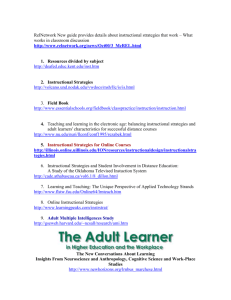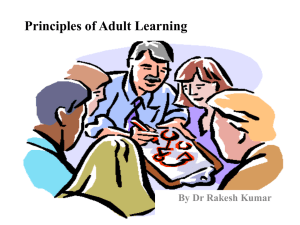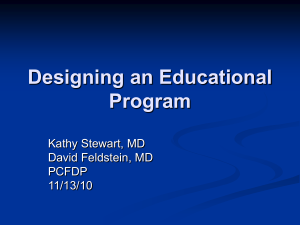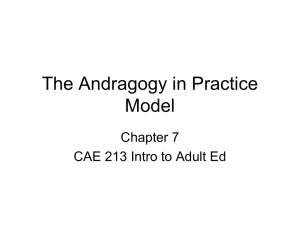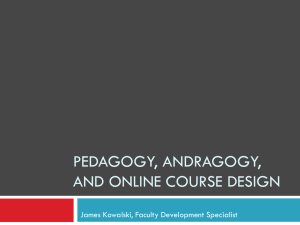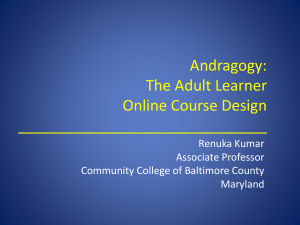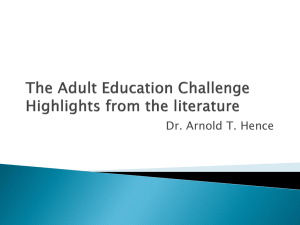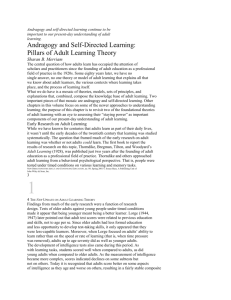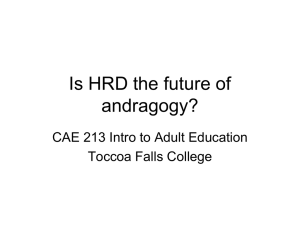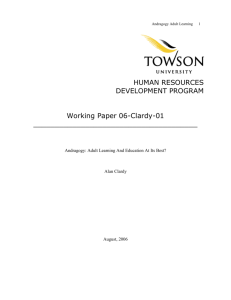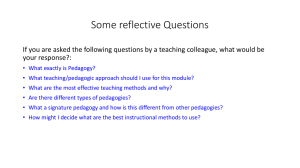File - Keith Coutu M.Ed Portfolio
advertisement
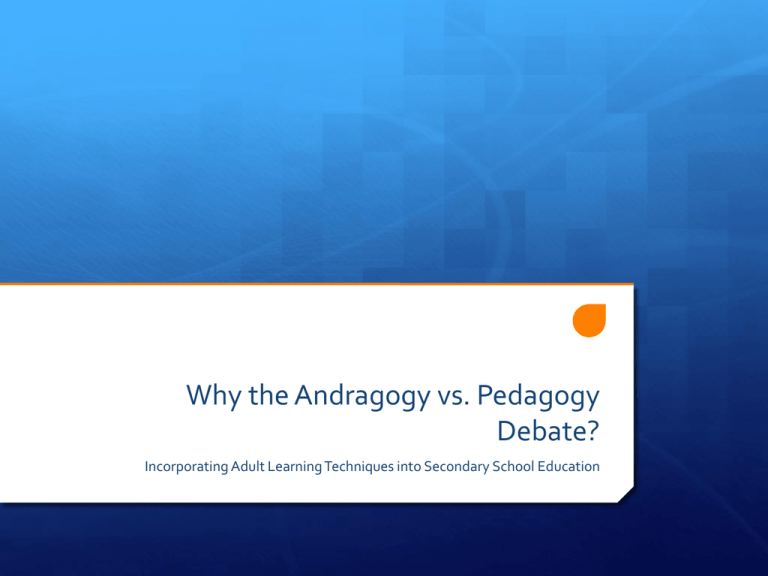
Why the Andragogy vs. Pedagogy Debate? Incorporating Adult Learning Techniques into Secondary School Education Personal Interest Different Teaching Techniques New Generation of Students History Curriculum Engagement Andragogy Introduction Topics to investigate: teacher training and methods; digital technologies; and the new generation of students. Is pedagogy and andragogy all that different? The problems with andragogy Definition, theory, method, technique, set of assumptions Can andragogy be used outside of adult education? M.Ed Research project Surveys, observations and analysis Conclusions It seems unnecessary to define andragogy as separate from pedagogy. Andragogy is best viewed as a teaching technique. Activities that involve self-directed learning, draw from personal experience, target society and social roles and a problem-basedlearning environment. Teachers can incorporate andragogical techniques into their activities and lesson plans. It is not necessary for andragogy to begin at post-secondary institutes. References Darbyshire, Philip (1993). “In defence of pedagogy: A critique of the notion of andragogy” Nurse Education Today. Vol. 13, Pg 328-335. Davenport, Joseph & Davenport, Judith A (1985). “A Chronology and Analysis of the Andragogy Debate” Adult Education Quarterly. Vol. 35, No. 3, Pg. 152-159. Dewey, John (1916). Democracy and Education. http://books.google.ca/books?id=UkxjpfiY4nIC&printsec=frontcover&dq=Dewey+Democracy+and+education&s ource=bl&ots=0C5fbEwEYr&sig=cBCJd8VsDz9VOl_2OU7ZEZkRGE&hl=en&ei=KYL4TJKeMsT9nAeVnMCfAw&sa=X&oi=book_result&ct=result&resnum=4&ved=0CC4Q 6AEwAw#v=onepage&q&f=false Feuer, Dale & Geber, Beverly (1988). “Uh-Oh…Second Thoughts About Adult Learning Theory.Training. ProQuest Education Journals. Vol. 25, No. 12. Pg. 31-39. Garrison, D.R. (1997). “Self-Directed Learning: Towards a Comprehensive Model” Adult Education Quarterly. Vol. 48, No. 1, Pg. 18-33. Gilbert, Jane (2007) “Knowledge, the disciplines, and learning in the Digital Age” Educational Research for Policy and Practice. Vol. 6, Pg. 115-122. Greenhow, Christine (2008). Connecting informal and formal learning experiences in the age of participatory media: Commentary on Bull et al. (2008). Contemporary Issues in Technology and Teacher Education, Vol. 8, Iss. 3, Pg. 187-194. References con’t Imel, Susan (1989). “Teaching Adults: Is It Different?” ERIC Digest. No. 82. Columbus, Ohio: ERIC Clearinghouse on Adult Career and Vocational Education. Knowles, Malcolm S (1978). “Andragogy: Adult Learning Theory in Perspective” Community College Review. Vol. 5, No. 3, Pg 9-20. MacFarland, Thomas W (1985). A Strategy to Address the Needs of Adult Learners by Incorporating Andragogy into Vocational Education. Fort Lauderdale, Florida: Nova University Centre for Higher Education. Prensky, Marc (2001). “Digital Natives, Digital Immigrants” On the Horizon. NCB University Press. Vol. 9, No. 5. Salajan, Florin D., et al. (2010). “Student and Faculty intergenerational digital divide: Fact of Fiction?” Computers & Education. Vol. 55, Pg. 1393-1403. Schiro, Michael Steven (2008). Curriculum Theory: Conflicting Visions and Enduring Concerns. London, UK: Sage Publications Ltd. Skerrett, Alison & Hargreaves, Andy (2008). “Student Diversity and Secondary School Change in a Context of Increasingly Standardized Reform” American Educational Research Journal. December 2008, Vol. 45, No. 4, pg. 913-945. Schwartz, Daniel L & Arena, Dylan (2009). Choice-Based Assessment for the Digital Age. Stanford University, School of Education. Andragogy vs. Pedagogy Andragogy = Adult Education & Pedagogy = Child Education Knowles Assumptions: 1) as a person matures the self-concept moves from dependency towards self-direction; 2) maturity brings an accumulating reservoir of experience that becomes increasing resource for learning; 3) as the person matures, readiness to learn is increasingly oriented towards the person’s social roles; 4) as the person matures the orientation towards learning becomes less subject-centered and increasingly problem-centered. “What he once envisioned as unique characteristics of adult learners, [Knowles] now sees as innate tendencies of all human beings, tendencies that emerge as people mature” Feuer and Geber (1988, p. 33). Adding to the Debate Knowles (1979) views andragogy more as technique rather than a theory and states “some pedagogical assumptions are realistic for adults in some situations and some andragogical assumptions are realistic for children” (p. 52). Thompson (1989), argues that “the notion that all adults share a set of learner characteristics that differ from the learner characteristics of all children was found to be problematic“ (p. 2). While discussing the merits of voluntarism and willingness to learn, Darbyshire (1993) notes “it may be measurable by degree but assuredly not by age” (p. 329). Teacher and Student: A Digital Divide? Prensky (2001) proclaims, “[o]ur students today are all “native speakers” of the digital language of computers, video games and the Internet” (p. 1). Schwartz and Arena (2009) believe that “advances in new technologies will make it possible for students to experience a broader range of learning choices and their effects” (p. 10). Technology allows for students to generate new “experiences”. Teachers may be a step behind students regarding technological awareness. ICTs have not revolutionized teaching and learning, but they may have to soon. The New Student and an Adaptive Teacher Teachers are not required to be experts in a specific field anymore. Teachers need to become engineers or facilitators Prensky (2001) notes, “if Digital Immigrant educators really want to reach Digital Natives – i.e. all their students – they will have to change” (p. 6). Schiro (2008), while discussing a Learner Centered Ideology, identifies a curricula that should focus on the “contexts, environments, or units of work in which students can make meanings for themselves by interacting with other students, teachers, ideas, and things” (p. 6). Andragogical techniques can and should be incorporated into secondary school education. Analysis and Recommendations One of the most notable problems comes from trying to define andragogy. More research needs to be completed in order to understand the merits of andragogy. Specifically in fields other than Adult Ed. More research needs to be completed to fully understand if there is a digital divide. Specifically regarding Gen Y students Modifications and Improvements Need to add about 1000 words; and maybe 3-4 more articles Refer to general human development vs. Knowles assumptions More in-depth regarding the Digital Divide and how it relates to andragogy The new tech savvy generation of students will benefit from andragogy Connect technology to K-12 education (recent trends, how could andragogy fit in) References, studies or analysis regarding younger generations learning styles Helpful Suggestions Should andragogy be Adult Ed specific? Is andragogy a theory, method, technique, set of assumptions or something entirely different? Is it critical to define andragogy? Is there a digital divide that exists between teachers and students Would andragogical techniques be useful in a History classroom? Activities that involve self-directed learning, draw from personal experience, target society and social roles and a problem-based-learning environment Can digital technologies, coupled with andragogical techniques (activities listed above) engage students?
